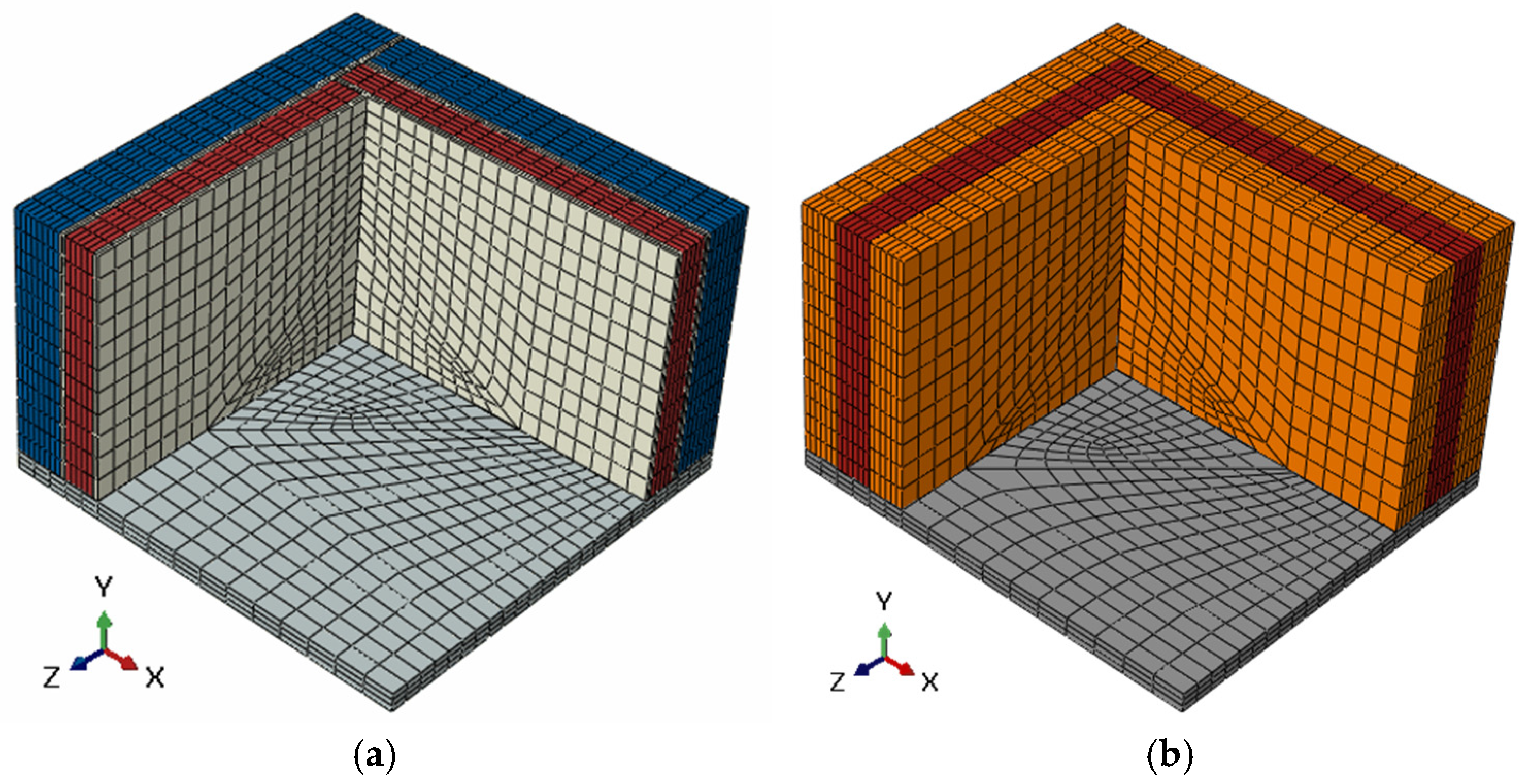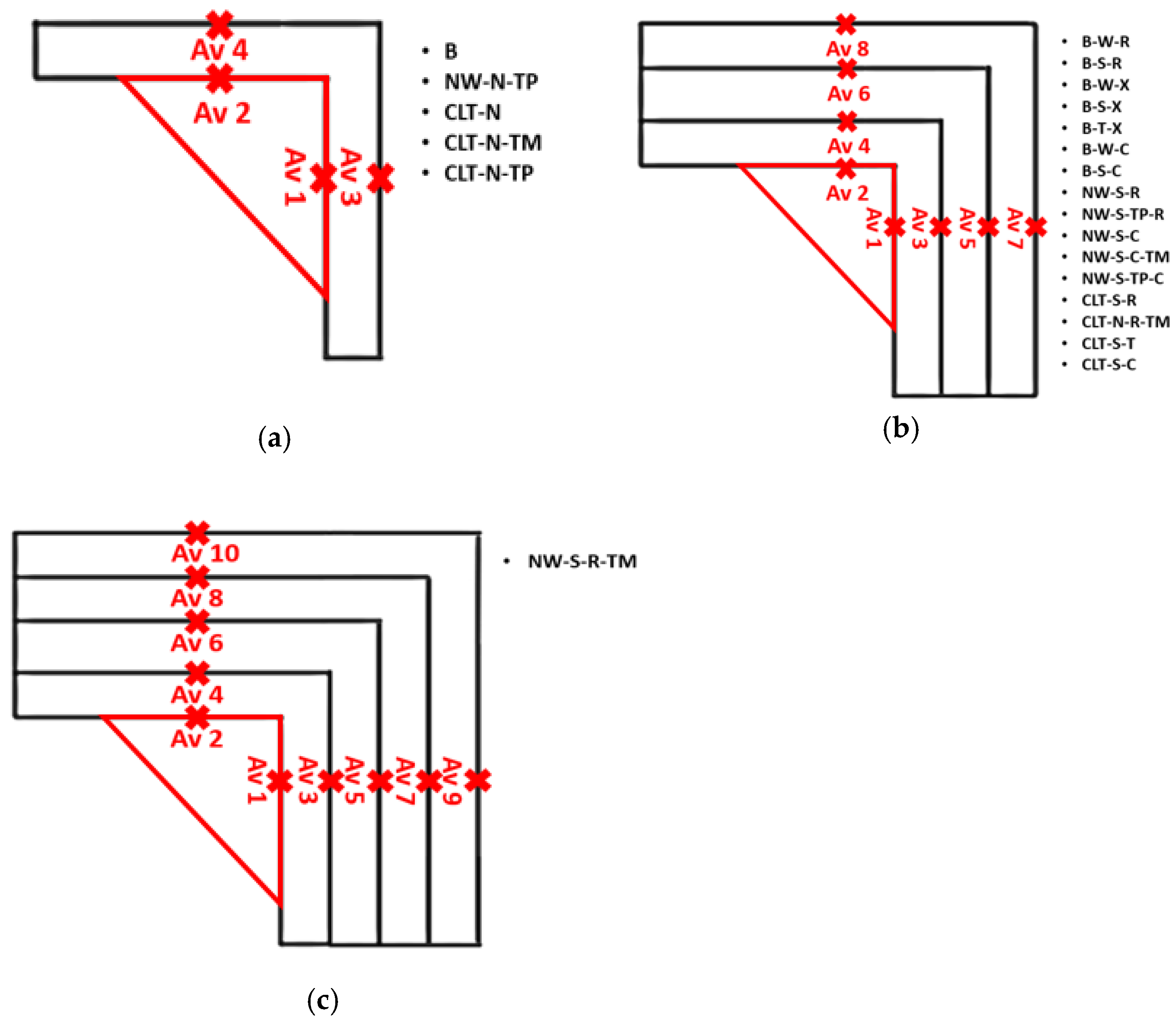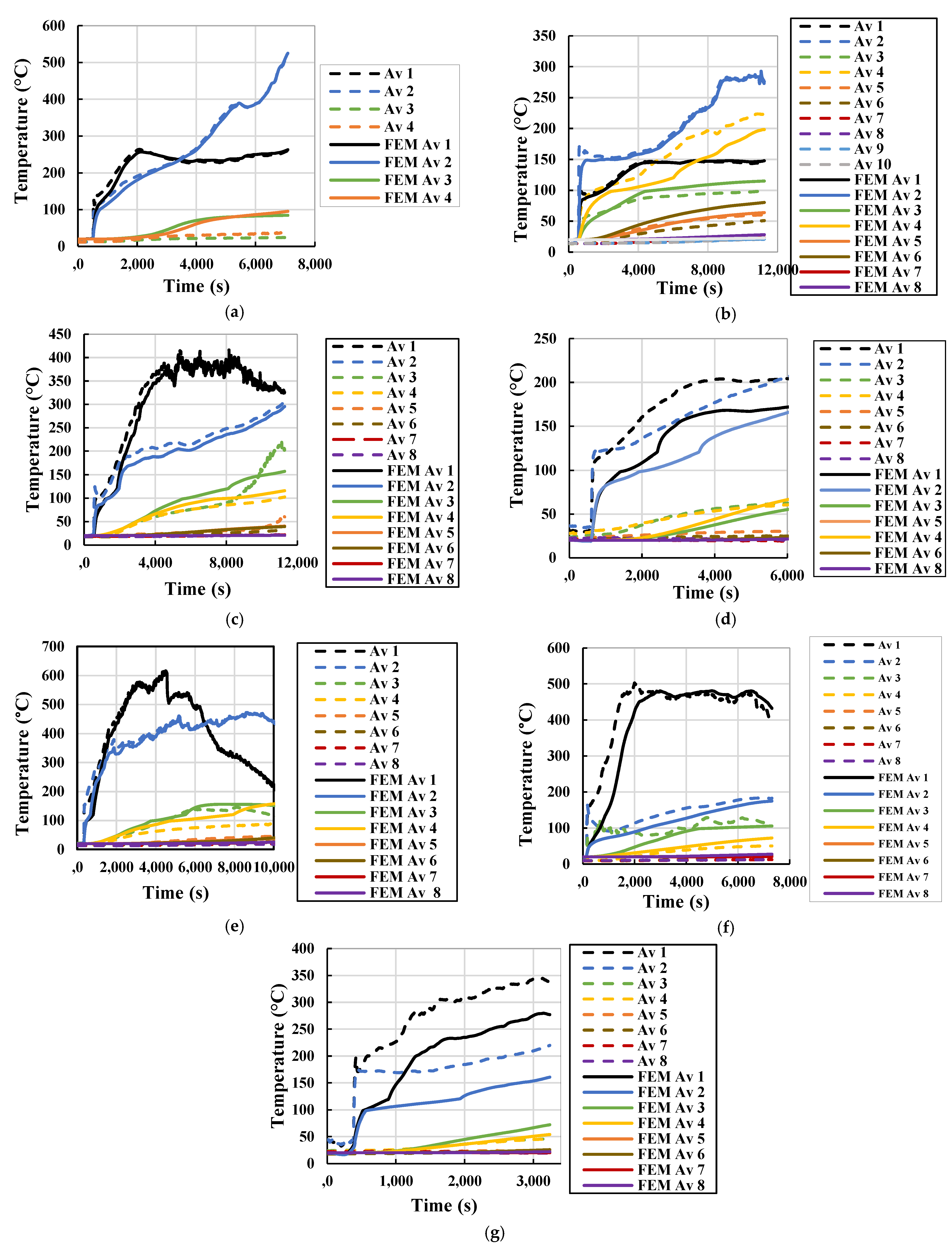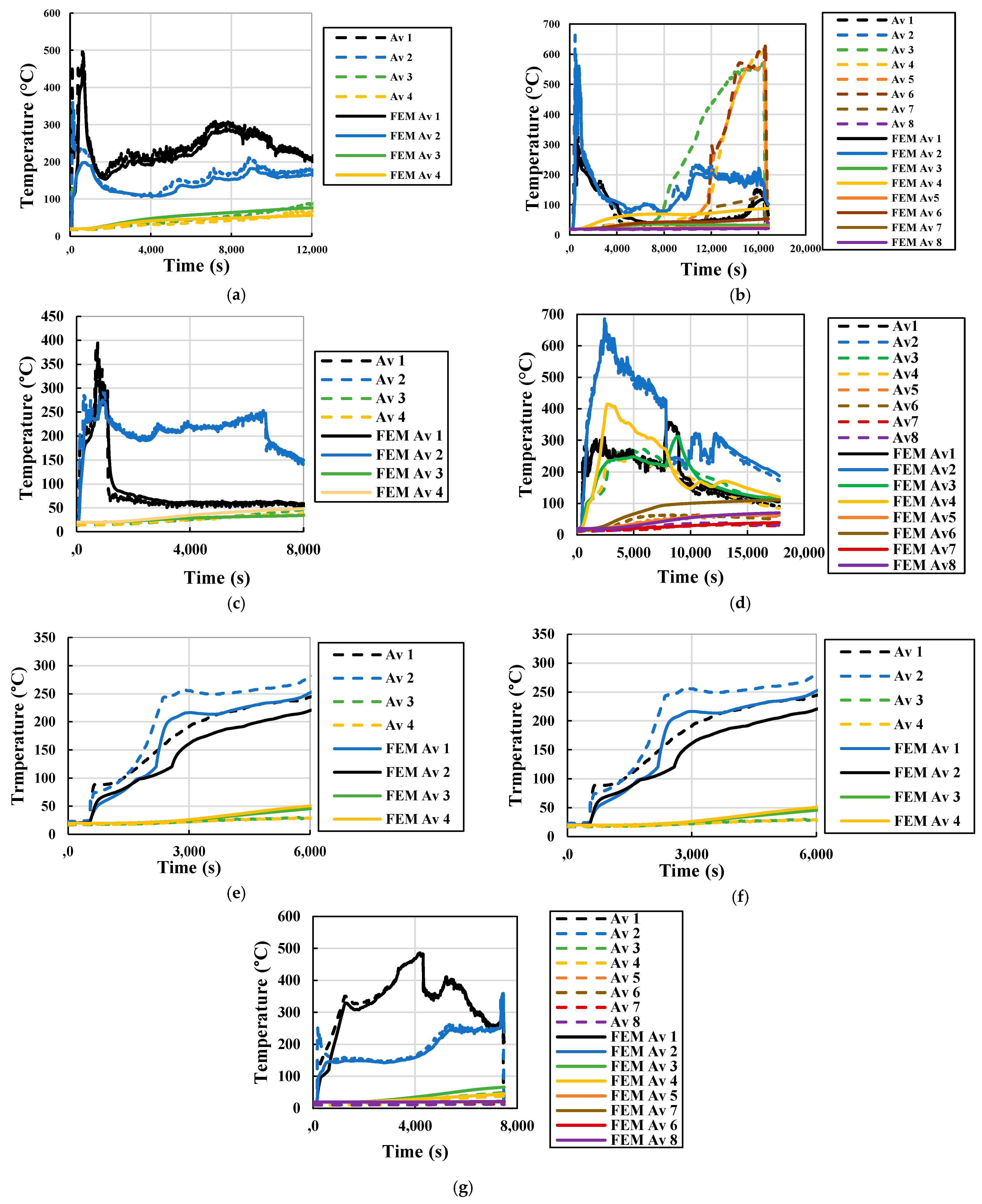Numerical Simulation of the Thermal Effect of Firebrand Deposition on External Composite Walls
Abstract
1. Introduction
2. Materials and Methods
2.1. Experimental Campaign Summary
2.2. Numerical Simulation
2.2.1. Material Properties
2.2.2. Firebrand Input and Boundary Conditions
2.2.3. Chosen Mesh
3. Results
3.1. Brick Wall Specimens
3.2. NW Wall Specimens
3.3. CLT Wall Specimens
4. Discussion
4.1. Limitations of the Study
4.2. Future Developments
5. Conclusions
- The finite element simulations successfully modeled the thermal response of most brick wall specimens, with predicted results showing good agreement with the experimental data. However, discrepancies were observed for wall specimens incorporating XPS insulation, as the numerical model did not account for the melting of XPS during the tests.
- For normal wood wall specimens, the simulations captured the impact of firebrand accumulation with reasonable accuracy. Nonetheless, wall specimens treated with Tria Paint exhibited discrepancies due to the exclusion of the protective coating’s effects in the model.
- Similarly, the finite element simulations effectively reproduced the thermal response of most CLT wall specimens. However, the specimen with rockwool and sandwich settings displayed a marked deviation from experimental results, attributed to uncontrolled combustion during firebrand accumulation tests.
Author Contributions
Funding
Data Availability Statement
Acknowledgments
Conflicts of Interest
References
- Jones, M.W.; Kelley, D.I.; Burton, C.A.; Di Giuseppe, F.; Barbosa, M.L.F.; Brambleby, E.; Hartley, A.J.; Lombardi, A.; Mataveli, G.; McNorton, J.R.; et al. State of Wildfires 2023–2024. Earth Syst. Sci. Data 2024, 16, 3601–3685. [Google Scholar]
- Penney, G.; Baker, G.; Valencia, A.; Gorham, D.J.F. A fire safety engineering approach to improving community resilience to the impacts of wildfire. Fire Mater. 2024. [Google Scholar] [CrossRef]
- Guerreiro, J.; Fonseca, C.; Salgueiro, A.; Fernandes, P.; Lopez, I.E.; Neufville, R.; Mateus, F.; Castellnou, R.M.; Sande, S.J.; Moura, J.M.; et al. Avaliação dos Incêndios Ocorridos Entre 14 e 16 de Outubro de 2017 em Portugal Continental; Assembleia da República: Lisboa, Portugal, 2018. [Google Scholar]
- IFRC. Portugal: Wildfires—DREF Operation (MDRPT001); International Federation of Red Cross and Red Crescent Societies: Geneva, Switzerland, 2024. [Google Scholar]
- Jain, P.; Barber, Q.E.; Taylor, S.W.; Whitman, E.; Castellanos Acuna, D.; Boulanger, Y.; Chavardès, R.D.; Chen, J.; Englefield, P.; Flannigan, M.; et al. Drivers and Impacts of the Record-Breaking 2023 Wildfire Season in Canada. Nat. Commun. 2024, 15, 6764. [Google Scholar] [CrossRef]
- Holliday, R.; Krishnamurti, L.S.; Jordan, S.E.; Sia, M.A.; Brenner, L.A.; Monteith, L.L. The Health and Social Impacts of the Maui Wildfires: Post-Disaster Care from a Sociocultural Lens. Hawai’i J. Health Soc. Welf. 2024, 83, 85–87. [Google Scholar] [CrossRef]
- NASA Earth Observatory. Fires Scar the Chilean Landscape. NASA Earth Observatory, 2024. Available online: https://earthobservatory.nasa.gov/images/150994/fires-scar-the-chilean-landscape (accessed on 18 March 2025).
- Business Standard. Los Angeles Wildfires: Deaths, Damages, Evacuations. Business Standard, 2025. Available online: https://www.business-standard.com/world-news/los-angeles-wildfires-deaths-damages-evacuations-2025-125011300426_1.html (accessed on 18 March 2025).
- Suzuki, S.; Manzello, S.L. Investigating the effect of structure to structure separation distance on firebrand accumulation. Front. Mech. Eng. 2021, 6, 628510. [Google Scholar]
- Dossi, S.; Węgrzyński, W.; Rein, G.J.F. Exploratory Simulations on the Effectiveness of Sand Protection Strategies Against Firebrand Accumulation in Wildfires. Fire Mater. 2025. [Google Scholar] [CrossRef]
- Mell, W.E.; Manzello, S.L.; Maranghides, A.; Butry, D.; Rehm, R.G. The wildlandurban interface fire problem current approaches and research needs. Int. J. Wildland Fire 2010, 19, 238–251. [Google Scholar] [CrossRef]
- Suzuki, S.; Manzello, S.L. Investigating Coupled Effect of Radiative Heat Flux and Firebrand Showers on Ignition of Fuel Beds. Fire Technol. 2021, 57, 683–697. [Google Scholar] [CrossRef]
- Wang, H.-H. Analysis on Downwind Distribution of Firebrands Sourced from a Wildland Fire. Fire Technol. 2011, 47, 321–340. [Google Scholar] [CrossRef]
- Tarifa, C.S.; Notario, P.P.d.; Moreno, F.G. On the flight paths and lifetimes of burning particles of wood. Symp. (Int.) Combust. 1965, 10, 1021–1037. [Google Scholar] [CrossRef]
- Albini Usda, F.A. Transport of Firebrands by Line Thermals. Combust. Sci. Technol. 1983, 32, 277–288. [Google Scholar] [CrossRef]
- Matvienko, O.V.; Fil’kov, A.I.; Grishin, A.M. Computational Investigation of the Transport of Burning Particles. J. Eng. Phys. Thermophys. 2016, 89, 1315–1324. [Google Scholar] [CrossRef]
- Arruda, M.R.T.; Cantor, P.; Bicelli, A.; Branco, F. Thermal reaction of firebrand accumulation in construction materials. Case Stud. Constr. Mater. 2024, 20, e02985. [Google Scholar] [CrossRef]
- Wadhwani, R.; Sullivan, C.; Wickramasinghe, A.; Kyng, M.; Khan, N.; Moinuddin, K. A review of firebrand studies on generation and transport. Fire Saf. J. 2022, 134, 103674. [Google Scholar] [CrossRef]
- Manzello, S.L.; Shields, J.R.; Hayashi, Y.; Nii, D. Investigating the vulnerabilities of structures to ignition from a firebrand attack. Fire Saf. Sci. 2008, 9, 143–154. [Google Scholar] [CrossRef]
- Manzello, S.L.; Shields, J.R.; Cleary, T.G.; Maranghides, A.; Mell, W.E.; Yang, J.C.; Hayashi, Y.; Nii, D.; Kurita, T. On the development and characterization of a firebrand generator. Fire Saf. J. 2008, 43, 258–268. [Google Scholar] [CrossRef]
- Manzello, S.L.; Suzuki, S. Experimental investigation of wood decking assemblies exposed to firebrand showers. Fire Saf. J. 2017, 92, 122–131. [Google Scholar] [CrossRef]
- Santamaria, S.; Kempná, K.; Thomas, J.C.; El Houssami, M.; Mueller, E.; Kasimov, D.; Filkov, A.; Gallagher, M.R.; Skowronski, N.; Hadden, R. Investigation of structural wood ignition by firebrand accumulation. In Proceedings of the First International Conference on Structures Safety Under Fire Blast, Glasgow, UK, 2–4 September 2015; pp. 1–13. [Google Scholar]
- Suzuki, S.; Manzello, S.L. Experimental investigation of firebrand accumulation zones in front of obstacles. Fire Saf. J. 2017, 94, 1–7. [Google Scholar] [CrossRef] [PubMed]
- Suzuki, S.; Manzello, S.L. Role of accumulation for ignition of fuel beds by firebrands. Appl. Energy Combust. Sci. 2020, 1-4, 100002. [Google Scholar] [CrossRef]
- Bicelli, A.R.; Cantor, P.; Arruda, M.R.; Tiago, C.; Bernardes de Assis, E.; Branco, F. Numerical Assessment of Standard Firebrand Accumulation Curve When Transferring Temperature to Contact Surfaces. Appl. Sci. 2023, 13, 9657. [Google Scholar] [CrossRef]
- Zhu, L.; Urban, J.L. Analyzing the ignition capabilities of glowing firebrand accumulations. Proc. Combust. Inst. 2024, 40, 105746. [Google Scholar] [CrossRef]
- Arruda, M.R.T.; Bicelli, A.R.A.; Branco, F. Ignition Locations and Simplified Design Guidelines for Enhancing the Resilience of Dwellings against Wildland Fires. Fire 2024, 7, 40. [Google Scholar] [CrossRef]
- Zitouni, M.; Arruda, M.R.T.; Cantor, P.; Branco, F. Heat Penetration and Thermal Response due to Firebrand Accumulation on the Exterior Walls of Dwellings. J. Saf. Sci. Resil. 2025. [Google Scholar] [CrossRef]
- International Code Council. California Building Code Part 2 Vol. 1 and 2; International Code Council: Washington, DC, USA, 2016. [Google Scholar]
- ABAQUS, v. 2018; Dassault Systemes Simulia Corporation: Johnston, RI, USA, 2018. [Google Scholar]
- European Committee for Standardization (CEN). Eurocode 2: Design of Concrete Structures—Part 1–2: General Rules—Structural Fire Design; European Committee for Standardization (CEN): Brussels, Belgium, 2004. [Google Scholar]
- Thomas, H.R.; Zhou, Z. Minimum time-step size for diffusion problem in FEM analysis. Int. J. Numer. Methods Eng. 1997, 40, 3865–3880. [Google Scholar] [CrossRef]
- CEN. Eurocode 5: Design of Timber Structures—Part 1–2: General Rules—Structural Fire Design; Comité Européen de Normalisation: Brussels, Belgium, 2004. [Google Scholar]
- CEN. Eurocode 6: Design of Masonry Structures—Part 1–2: General Rules—Structural Fire Design; Comité Européen de Normalisation: Brussels, Belgium, 1996. [Google Scholar]
- Correia, M.J.S. Fire and High Temperature Behaviour of Thermal Mortars; Instituto Superior Técnico, Universidade de Lisboa: Lisbon, Portugal, 2022. [Google Scholar]
- Leppänen, P.; Neri, M.; Mäkinen, J. Heat release caused by the smouldering combustion of the binder of rockwool. Raken. Mek. (J. Struct. Mech.) 2015, 48, 68–82. [Google Scholar]
- Duarte, A.P.C.; Mazzuca, P.; Lopo de Carvalho, J.M.; Tiago, C.; Firmo, J.P.; Correia, J.R. Determination of the temperature-dependent thermophysical properties of polymeric foams using numerical inverse analysis. Constr. Build. Mater. 2023, 394, 131980. [Google Scholar] [CrossRef]
- Bergman, T.L. Fundamentals of Heat and Mass Transfer; John Wiley & Sons: Hoboken, NJ, USA, 2011. [Google Scholar]
- Bicelli, A.R.; Cantor, P.; Arruda, M.R.; Duarte, A.; Tiago, C.; Branco, F.; Trindade, J. Propriedades Termofísicas de Aglomerado de Cortiça para Temperaturas Elevadas: Avaliação Experimental e Numérica. In Proceedings of the Livro de Atas 5º Congresso Luso-Brasileiro de Materiais de Construção Sustentáveis | Congresso Construção 2024, Lisbon, Portugal, 6–8 November 2024; pp. 967–978. [Google Scholar]
- Morgado, T.; Silvestre, N.; Correia, J.; Branco, F.; Keller, T. Numerical modelling of the thermal response of pultruded GFRP tubular profiles subjected to fire. Compos. Part B Eng. 2017, 137, 202–216. [Google Scholar] [CrossRef]
- Bearinger, E.D.; Hodges, J.L.; Yang, F.; Rippe, C.M.; Lattimer, B.Y. Localized heat transfer from firebrands to surfaces. Fire Saf. J. 2021, 120, 103037. [Google Scholar] [CrossRef]
- European Committee for Standardization (CEN). Eurocode 1: Actions on Structures—Part 1–2: General Actions—Actions on Structures Exposed to Fire; European Committee for Standardization (CEN): Brussels, Belgium, 2002. [Google Scholar]
- Hottel, H.C. Radiant Heat Transmission Between Surfaces Separated by Non-Absorbing Media. Trans. Am. Soc. Mech. Eng. 2023, 53, 265–271. [Google Scholar] [CrossRef]
- Wessies, S.S.; Chang, M.K.; Marr, K.C.; Ezekoye, O.A. Experimental and Analytical Characterization of Firebrand Ignition of Home Insulation Materials. Fire Technol. 2019, 55, 1027–1056. [Google Scholar] [CrossRef]










| Wall Designation | Structural Material | Setting Method | Protective Coating | Thermal Insulation Material | Mortar |
|---|---|---|---|---|---|
| B | Brick | ETICS | None | None | None |
| B-W-R | Brick | ETICS | None | Rockwool | Weber |
| B-S-R | Brick | ETICS | None | Rockwool | Sika |
| B-W-X | Brick | ETICS | None | XPS | Weber |
| B-S-X | Brick | ETICS | None | XPS | Sika |
| B-T-X | Brick | ETICS | None | XPS | Tria |
| B-W-C | Brick | ETICS | None | Cork | Weber |
| B-S-C | Brick | ETICS | None | Cork | Sika |
| NW-N-TP | Normal Wood | Normal | Tria Paint | None | None |
| NW-S-R-TM | Normal Wood | Sandwich | None | Rockwool | Tria Mortar |
| NW-S-R | Normal Wood | Normal | None | Rockwool | None |
| NW-S-TP-R | Normal Wood | Sandwich | Tria Paint | Rockwool | None |
| NW-S-C | Normal Wood | Sandwich | None | Cork | None |
| NW-S-C-TM | Normal Wood | Sandwich | None | Cork | Tria Mortar |
| NW-S-TP-C | Normal Wood | Sandwich | Tria Paint | Cork | None |
| CLT-N | CLT | Normal | None | None | None |
| CLT-S-R | CLT | Sandwich | None | Rockwool | None |
| CLT-N-TM | CLT | Normal | None | None | Tria Mortar |
| CLT-N-R-TM | CLT | Normal | None | Rockwool | Tria Mortar |
| CLT-N-TP | CLT | Normal | Tria Paint | None | None |
| CLT-S-TP-R | CLT | Sandwich | Tria Paint | Rockwool | None |
| CLT-S-C | CLT | Sandwich | None | Cork | None |
| Material | Density (kg/m3) | Thermal Conductivity (W/m·K) | Specific Heat (J/(kg K)) |
|---|---|---|---|
| Brick | 1050 | 0.7 | 564 |
| NW | 510 | 0.12 | 1530 |
| CLT | 354 | 0.14 | 1530 |
| Rockwool | 140 | 0.04 | 840 |
| XPS | 55 | 0.027 | 1210 |
| Cork | 219.8 | 0.04 | 899.5 |
| Weber/Sika | 1400 | 0.45 | 360 |
| Tria | 760 | 0.122 | 360 |
Disclaimer/Publisher’s Note: The statements, opinions and data contained in all publications are solely those of the individual author(s) and contributor(s) and not of MDPI and/or the editor(s). MDPI and/or the editor(s) disclaim responsibility for any injury to people or property resulting from any ideas, methods, instructions or products referred to in the content. |
© 2025 by the authors. Licensee MDPI, Basel, Switzerland. This article is an open access article distributed under the terms and conditions of the Creative Commons Attribution (CC BY) license (https://creativecommons.org/licenses/by/4.0/).
Share and Cite
Zitouni, M.; Bicelli, A.R.A.; Arruda, M.R.T.; Branco, F. Numerical Simulation of the Thermal Effect of Firebrand Deposition on External Composite Walls. J. Compos. Sci. 2025, 9, 151. https://doi.org/10.3390/jcs9040151
Zitouni M, Bicelli ARA, Arruda MRT, Branco F. Numerical Simulation of the Thermal Effect of Firebrand Deposition on External Composite Walls. Journal of Composites Science. 2025; 9(4):151. https://doi.org/10.3390/jcs9040151
Chicago/Turabian StyleZitouni, Mohamed, Antonio Renato Albuquerque Bicelli, Mário Rui Tiago Arruda, and Fernando Branco. 2025. "Numerical Simulation of the Thermal Effect of Firebrand Deposition on External Composite Walls" Journal of Composites Science 9, no. 4: 151. https://doi.org/10.3390/jcs9040151
APA StyleZitouni, M., Bicelli, A. R. A., Arruda, M. R. T., & Branco, F. (2025). Numerical Simulation of the Thermal Effect of Firebrand Deposition on External Composite Walls. Journal of Composites Science, 9(4), 151. https://doi.org/10.3390/jcs9040151








